#Third Day of Navratri
Explore tagged Tumblr posts
Text
Today, we will discuss the significance of Goddess Chandraghanta, the Third Day of Navratri. She is a powerful form of Maa Durga, known for her courage, grace, and warrior spirit. Her name comes from the crescent moon (Chandra) on her forehead, which shines like a bell which is called Ghanta, symbolizing peace and bravery. Also you can your kundali matching with us.
#Third Day of Navratri 2025#Third Day of Navratri#Third Day Navratri#Navratri 2025#Navratri#festival#kundlimatching
1 note
·
View note
Video
मां शक्ति का वास हो Navratri shorts video, Hindikavita, motivationalvide...
#youtube#मां शक्ति का वास हो Navratri shorts video#Hindikavita#hindi poetry#hindi shayari#hindi quotes#bhakti quotes#jai mata di#navratri third day status#navratri
0 notes
Note
Hi! Fellow desi here...
So Navratri is coming soon and I am really excited already!! Can you please write something about spending Navratri with Lando. It would be like teaching him the garba steps and the reader being obsessed with garba and Lando just being in awe.
I love your writing sooo much <3

Desi Girl ༉‧₊˚.
彡 ln x desi!reader 🪷
彡 fluff + smau 🪷
masterlist ☾☼

being an indian meant that there was some festival or the other every few months. that meant new clothes, new jewellery, and the same old feeling of being blessed by the gods and goddesses. for most indians, the blessings of the almighty was all they sought throughout the year.
navratri was one of y/n's favourite festivals. nine days of music, dance, and worshipping different goddessess. every year, y/n bought nine new chaniya cholis for the festival, and every year she danced all night till her feet had blisters. it was the happiest she ever felt.
this year was different though, because she had a boyfriend. a boyfriend who was hot and rich and very much british. since the festival and the autumn break coincided, lando had decided to spend the break with his girlfriend in india. y/n had taken him shopping to all kinds street markets, where all he really did was hold her bags, give his opinion when asked, and made sure that she was hydrated. he had watched as she bargained, and tried on jhumkas, and smiled and laughed even though the sun was scorching hot.
the first two days of navratri had been y/n doing garba with her family and friends, and lando watching from afar, afraid to step into the fast moving circles of humans who were dancing in perfect sync. everyone was sweaty, especially his girlfriend, but she seemed to shine in the sweat. that just made lando fall in love even more.
on the third day, y/n had decided that she would teach lando the basic steps of garba. she took him in a little corner, not too secluded, but there was enough space for him to practice. she taught him the footwork of the dance, but even after multiple tries, lando tripped way more than he ever thought was imaginable. his girlfriend laughed though, so he hadn't completely failed at dancing.
he had tried participating with her friends, where they were all doing the same basic steps that y/n had been teaching him. after a few minutes of stepping on people's toes, and people stepping on his toes, lando had given up, sweating, shining, smiling.
y/n had grabbed his hand and pulled him to the food stalls. lando had never eaten anything like it before, but y/n was excited, and she was happy, and lando eating whatever she wanted him to would make her happier, so who was he to question it?
their first stop had been the pani puri stall. it was certainly an experience to try and fit the entire puri in his mouth without staining his clothes. when he had complained to y/n that there was no way he could fit the whole thing in his mouth, she had smirked at him and said, "remember when i said that to you? that it wasn't going to fit in my mouth?"
lando was blushing, knowing exactly what she was talking about, "y/n,"
"what did you say to me then? ah, yeah, practice makes perfect," y/n had been smiling wide as she teased him. lando had choked on the pani puri, and y/n had laughed, patting his back.
they went through all the stalls, where y/n proceeded to stuff him full of food. it was all extremely spicy for him, and despite y/n laughing at how red he had gotten, lando was determined to not ruin the fun. eventually, she had fed him gulab jamuns, kheer, and so many other sweets, he had lost track.
after eating, lando and y/n walked around the area, talking and laughing, and he had never felt so in love. he repeatedly told her how beautiful she looked, and even at the tenth and hundredth time, y/n blushed just the same. god, she really was breathtaking.
"so, what's the next festival?" lando asked.
"well, navratri ends on saturday, and then we have dusshera on sunday, and then, about two weeks later, diwali! oh, are you going to stay? i mean, i know you have your training and you have to be at the mtc for work or whatever, but dusshera is really fun, cause my nana sits all of us kids down and tells us the whole story of lord ram and how he defeated ravan!" she was rambling, they both knew, but lando loved it.
"i'm going to make sure i'm here on sunday," lando said softly.
"yeah?" her small hands were squeezing his big ones in hope.
lando leaned in, kissing her softly, before he pulled back, "yeah,"
lando.jpg
♫ Desi Girl (From "Dostana")






liked by yourusername, oscarpiastri, and 801,572 others
lando.jpg who's the hottest girl in the world
view all 73,496 comments
yourusername your desi girl <3
user1 is this a hard launch??? ARE WE HARD LAUNCHING RIGHT NOW???
user1 LANDO IN INDIA??? HELLO??? WHY WERE WE NOT TOLD???
user2 he better get an indian passport now
user3 jijaji pt.2???
carlossainz making the most of the break, i see
carlossainz spanish food or indian food?
lando.jpg 🤐
yourusername im watching you, norris
user2 HOLD ON DID LANDO DO GARBA?????
☪︎ ִ ࣪𖤐 𐦍 ☾𖤓
i'm not really a garba person, despite living in gujarat for quite a while, but this is specifically for my desi girls, cause we gotta feed our delusions somehow to live, right? i hope you enjoy it! i've also got a link for my taglist and requests that you can find here! i'd love your support! https://ko-fi.com/kavi2305
#f1#formula 1#lando norris#ln4#formula one#lando norris imagine#lando norris x reader#lando norris x you#lando norris fanfic#lando norris smau#lando x reader#lando x y/n#lando x desi!reader#ln4 x desi!reader#lando norris x desi!reader#desi f1blr#f1 imagine#f1 fanfic#☾☼#✧.*
189 notes
·
View notes
Text
9 Vibrant Navratri Outfit Ideas To Celebrate Each Night In Style

Navratri, one of the prominent festivals in India is a time of joy, dance, and colourful celebrations. Each of the nine nights is marked by a specific colour, offering a wonderful excuse to showcase your style.
Let’s explore some outfits that will help you look your best each day of the festival.
Day 1: Yellow
Kick off the festival with a burst of sunshine! The Nayab Mishti Yellow Floral Angrakha Kurta Set is a perfect choice. This delightful outfit features intricate floral patterns that are both cheerful and elegant. Paired with a flowing dupatta, it gives a lovely traditional touch while keeping you comfortable for all the festivities.
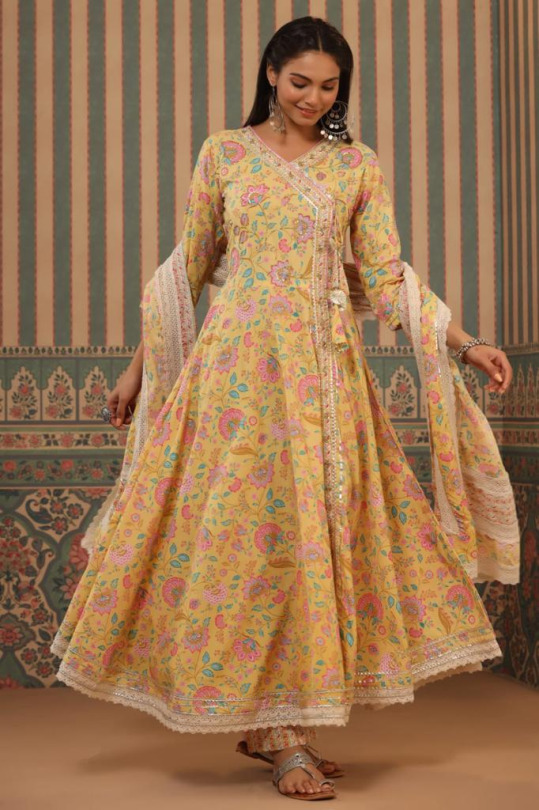
Day 2: Green
On the second day, opt for a refreshing vibe with the Chandani Heena Chanderi Hand Block Printed Dupatta. This dupatta, with its artistic hand-block prints, can elevate any outfit. You can wear it with a simple kurta or even a contemporary dress. The green hues symbolize growth and harmony, perfect for the spirit of the festival.

Day 3: Grey
For the third night, consider the sophisticated Farzeen Bridavan Phool Pleated Dress. The elegant grey fabric adorned with delicate floral prints offers a subtle yet chic look. With its pleated design, this dress enables easy of movement, making it ideal for dancing the night away while staying stylish.
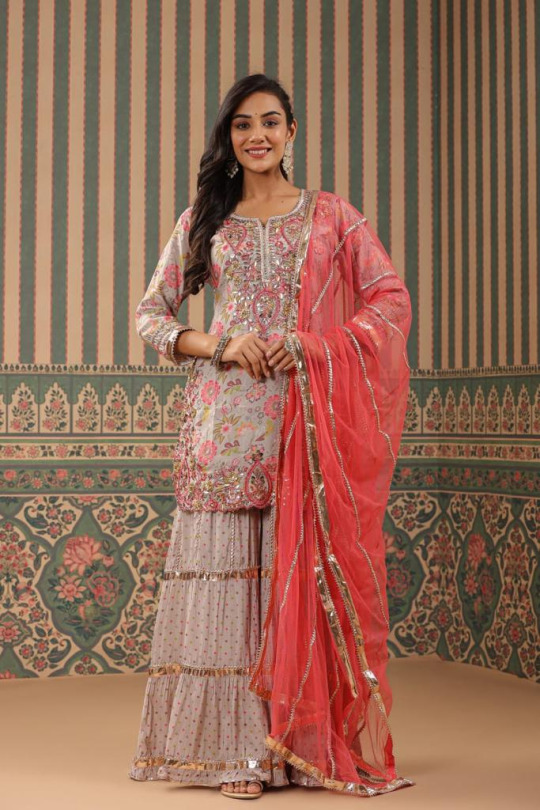
Day 4: Orange
Day four calls for vibrancy! The Faiza Bulbul Wajida Kurta and Palazzo Set in a striking orange is just the thing. This is a kurta that stands out with its beautiful peony patterns and offers a comfortable fit. It’s perfect for the lively garba nights, adding a pop of colour to your celebration.

Day 5: White
On the fifth day, opt for purity with the Gulnaaz Sherjeena White Cotton Kurta Set. This ensemble is both graceful and versatile. The lightweight cotton keeps you cool while the accompanying dupatta adds a touch of elegance. White symbolizes peace, making it a serene choice for the celebrations.
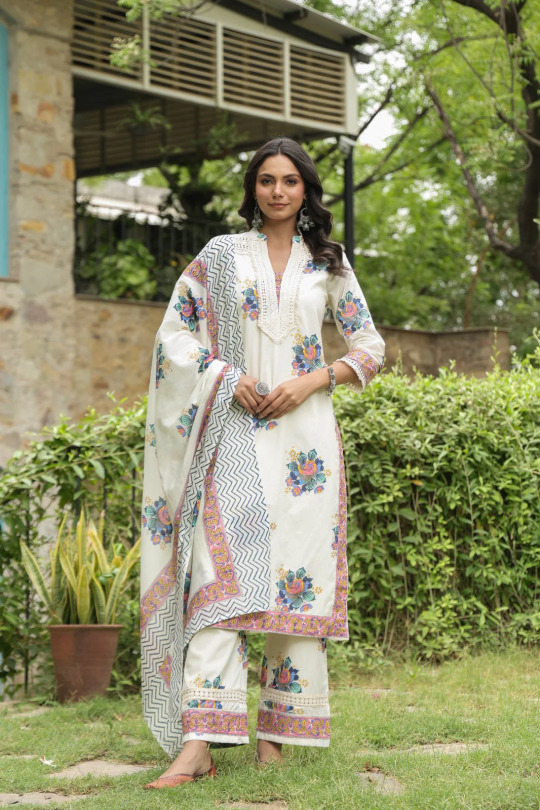
Day 6: Red
As we are halfway through, on the sixth day, wear the stunning Nayab Noor Maroon Muslin Kurta Set with Dupatta. The rich red colour is bold and festive, perfect for this spirited night. The luxurious silk fabric will make you feel special, while the intricate prints showcase the beauty of traditional craftsmanship.
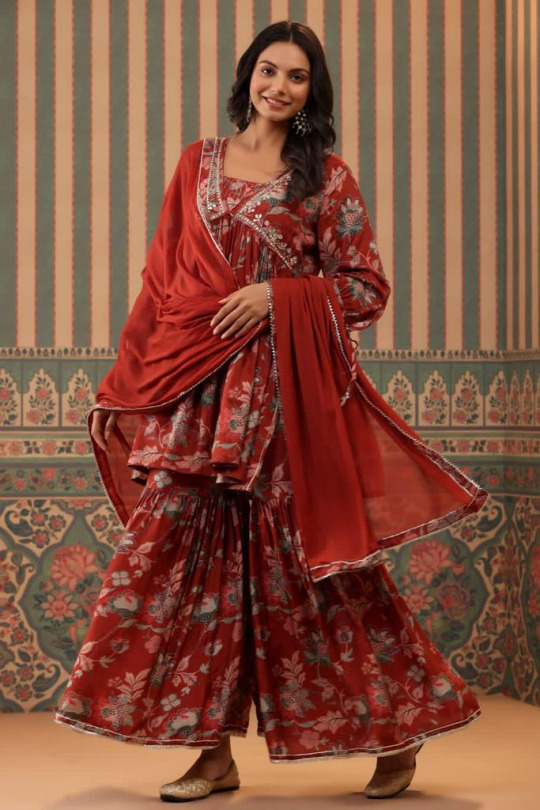
Day 7: Blue
For the seventh day, the Nayab Madhuri Aqua Floral Gharara Kurta Set With Dupatta offers a calm yet striking appearance. The blue tones create a beautiful contrast against the vibrant festivities. With block prints that tell a story, this kurta set is stylish and meaningful, making it a great choice for any Navratri event.
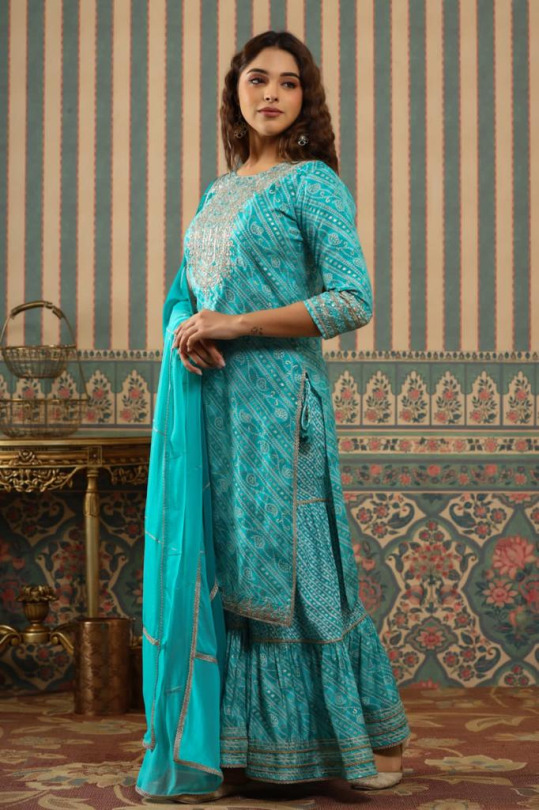
Day 8: Pink
Day eight is all about charm, and the Rooh Ruhani Pink Kurta Set with Dupatta is just that. This soft pink outfit radiates warmth and joy, making it perfect for the occasion. The flowy fabric and elegant design allow you to enjoy the night with ease, all while looking lovely.
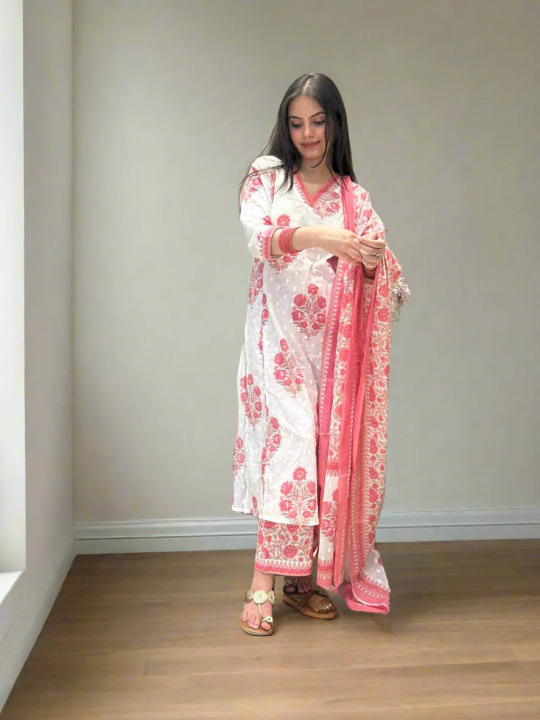
Day 9: Purple
Conclude the festival in style with the Nayab Madhuri Purple Floral Gharara Kurta Set. This gorgeous outfit features a stunning gharara style that is both trendy and traditional. The rich purple colour symbolizes luxury and creativity, making it a fitting finale for the celebrations.
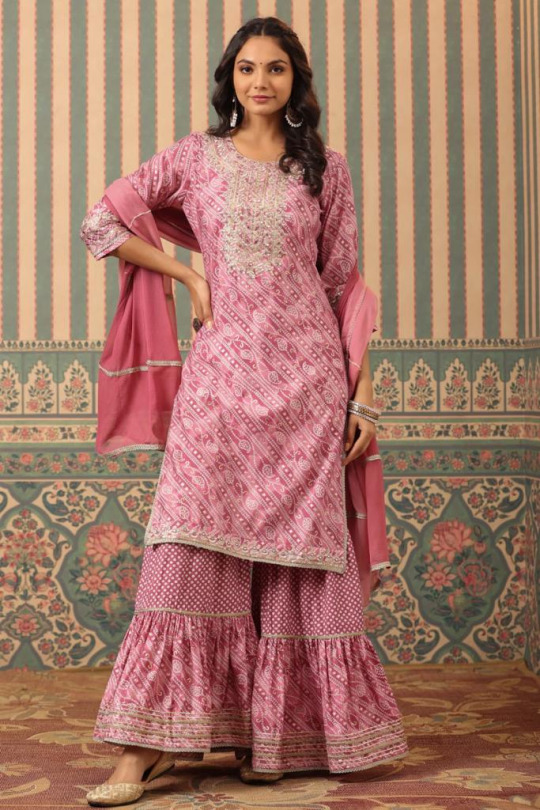
To sum up, as Navratri unfolds, these nine outfits will keep you stylish and comfortable throughout the festival. Each day’s colour not only reflects the spirit of the festival but also allows you to express your unique style. So, gear up, enjoy the festivities, and let your outfits tell a story!
#dress#online#indian print tops#india#cotton kurtis online#best cotton kurtis#designer kurti online#fashion#delhi#hinduism#mumbai
2 notes
·
View notes
Text
Hello friends 👋
जय माँ नव दुर्गा 🌹
Today it is the third day of Navratri for this year.
It is the day of Maa Chandraghanta.
Maa Chandraghanta has a third eye which symbolizes alertness and so she is always prepared to strike the evil.
So everyone, let's enjoy today's Navratri and pray to our Maa for prosperity and Happiness ☺
जय माँ चंद्रघंटा
Here is a link to our latest upload
Happy Navratri to you all ☺
youtube
#navratri#devotional#navdurga#durga#navratri special#chandraghanta#hindufestival#hinduism#hindu gods#youtube
2 notes
·
View notes
Text
Who is Lalita Mata, how did she originate?
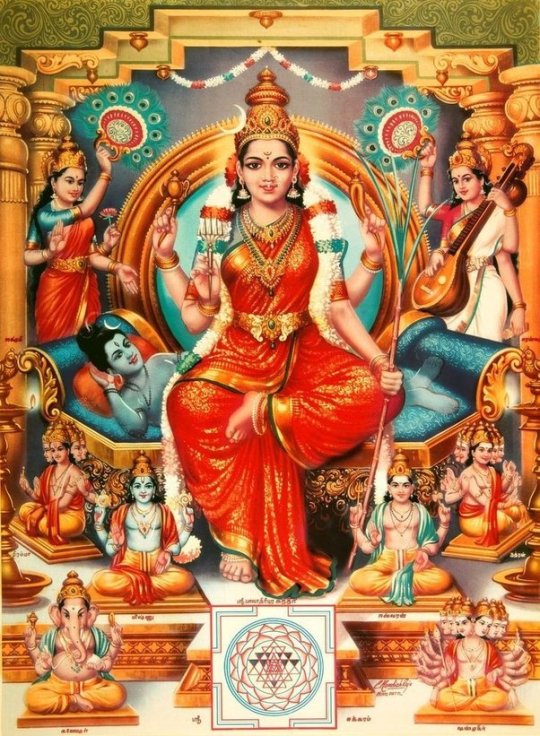
It is told in Brahmanda Purana that taking the name of Lord Shiva once gives the same result as taking the name of Maha Vishnu a thousand times. Similarly, taking the name of Mother Lalita once gives results equal to taking 1000 names of Lord Shiva. Let us know what we will know in today's article:-
1. Who is Lalita Mata?
2. How did Lalita Mata originate?
3. Mantra of Lalita Mata and 10 Mahavidyas
4. Benefits and advantages of reciting Lalita Chalisa
1. Who is Lalita Mata?
Lalita is the form of Mother Goddess Sati-Parvati. Lalita Mata is also known as Tripura Sundari, Shodashi and Lalita Tripurasundari. Mata Tripura Sundari is one of the 10 Mahavidyas.
There are three forms of Mother Lalita. Tripura Sundari in the form of an 8 year old girl, Shodashi at the age of 16 and the young form of mother Lalita is known as Tripura Sundari. Mother Lalita Tripura Sundari is expert in 16 arts, that is why she is also called Shodashi. Lalita Mata's birth anniversary is celebrated every year on the full moon date of Magh month. During Navratri, Lalita Panchami fast is observed along with Skandamata on the fifth day of Navratri. It is also called Upang Lalita Vrat. According to the Puranas, Lalita Mata has two arms. This mother is of fair complexion and is seated on a bloody lotus. According to the Dakshinamargi scriptures, Goddess Lalita has the place of 'Chandi'. Their method of worship is similar to that of Goddess Chandi. The meditative form of Goddess Lalita is very bright and luminous. Lalita Mata can be worshiped anytime but worshiping her on Lalita Jayanti or Lalita Panchami has special significance. On the day of Lalita Jayanti, there is a crowd of devotees of Mother Goddess in the temples. Skandamata and Lord Shiva are also worshiped on this day.
By worshiping Goddess Lalita, devotees attain happiness, prosperity and salvation. People become free from the bondage of life and death.
Lalita Mata's name comes third among the 10 Mahavidyas. The fast of Lalita Panchami is considered very auspicious and auspicious. It is believed that the person who worships Lalita Devi with true heart and full devotion gets the special blessings of Lalita Mata. Regarding this fast, Lord Shri Krishna has said that this fast is going to give happiness and wealth. Those who are childless get the happiness of having children. This fast is observed to pray for the happiness and long life of the child. Next we will know the mantra of Lalita Mata and which are the 10 Mahavidyas. But before that let us know the origin story of Lalita Mata.
2. How did Lalita Mata originate?
In the Puranas we find two stories about the origin of Lalita Mata. According to the story of Devi Purana, the story of origin of Lalita Mata is related to the sacrifice (death) of Mother Sati. Who is Goddess Sati? Let us know how the story of mother Lalita's origin is connected with her death.
Sati Ji, the incarnation of Mother Adishakti, is the daughter of Maharaj Daksh. When Sati saw Lord Shiva, she became fascinated by him and decided to marry him. Despite Maharaj Daksh not wanting, he married Sati to Lord Shiva.
Although Maharaj Daksh married Sati to Lord Shiva but he was not satisfied with that marriage. Mother Sati married as per her wish. Daksh did not like anything about Shivaji's behavior or attire.
Brahma Ji gave Maharaj Daksh the post of guardian of the people i.e. Prajapati. After getting the post of Prajapati, Maharaj Daksh became more arrogant. Often the attainment of great authority leads to arrogance in the mind. Who is like this in the world? One who is not intoxicated by attaining dominance. Once Brahma ji organized a religious assembly to formulate the religion. Great sages and gods were present in this religious gathering. Lord Shiva was also present in that meeting.
When Daksh Prajapati arrived there, all the sages, sages and gods stood up to welcome him. Only Brahma ji and Lord Shankar remained sitting at their places. Brahma ji is the mental father of Daksh Prajapati. Daksh bowed to Lord Brahma. Daksh Prajapati did not like Shankar ji sitting because Brahma ji was his father, hence he felt it was right for him not to stand, but Shiv ji was his son-in-law, so his not standing and not greeting him felt like an insult to Daksh. Prajapati Daksh was especially pained by the fact that his son-in-law Shankar ji did not salute him. Distressed by this, Maharaja Daksh strongly condemned Shankar ji. Shankar ji was called uncivilized and corrupt. They even cursed him that he would not get any part in any yagya. Even after this, Maharaj Daksh's anger did not subside.
Prajapati Daksh organized a huge yagya with the aim of humiliating Lord Shankar. All the sages, sages, gods and goddesses were invited to that yagya but Shankar ji and Mata Sati were not invited for the yagya. Seeing all the sages, sages and gods leaving in their respective planes, Goddess Sati asks Shankar ji where all these people are going. Then Lord Bholenath Shankar ji tells Devi Sati that your father Maharaj Daksh has organized a huge yagya. All these people are going to participate in that yagya. Goddess Sati said – Lord, I have not gone to my maternal home for a long time, a Yagya is being performed there, so my sisters will also definitely come. If you have permission, then both of us should also go there, even though they have not invited us, but it has been said that permission is not required to go to parents and teachers. Lord Shankar ji said that you are absolutely right that one does not need permission to go to parents and teachers. One can visit parents' and teachers' places even without inviting them. But here the matter is different. If someone believes in opposition then there is no benefit in going there. Maharaj Daksh does not like our coming there, he has deliberately not invited us, hence it would not be entirely appropriate to go there. Therefore, O Goddess, it would be appropriate to give up the idea of going there.
Even after the persuasion of Lord Shiva, Mother Sati started insisting on going to the Yagya. When Mother Sati did not agree, Lord Shankar ji sent her along with his followers Veerbhadra and Nandi. When Sati reached her peak, everyone started ignoring her. Maharaja Daksh did not show him any respect. When the sisters saw her, they started smiling sarcastically and said among themselves that look, Sati has come without invitation. There he met only his mother with love. When Goddess Sati came to the Yagyashala, she saw that all the gods had come there but no one had come there for Lord Shiva. Sati asks her father Maharaj Daksh why such contempt for Lord Shiva? Maharaj Daksh says very good and bad things about Shiva, he says that he does not consider Shiva as a god. He is the master of ghosts and devils. Gonna be naked. The one who applies crematorium ashes to his body and wears a garland of bones is not worthy of sitting in the ranks of the gods. Who will give him away? Hearing the words of Maharaj Daksh, Sati's eyes turned red in anger and she started saying that even if the name of Lord Shiva comes up in the context of conversation unexpectedly, all the sins of the person taking his name are destroyed. Who has the power to destroy the entire creation in a moment. They are my master. You hate Shiva like this. Your end is near, Maharaj.
For a woman, her husband is heaven. A woman who hears derogatory words about her husband has to go to hell. You have hatred towards Lord Shiva. Therefore, I will immediately abandon this body of mine, born from your intercourse, because this body is like a skeleton for me. Saying this, Sati meditated on Lord Shiva and burnt her body in the fire of Yagya Kund. Mother Sati's divine love for her husband is a great role model for women even today. Angered by her father's insult to her husband, Sati jumped into the Yagya Kund and sacrificed her life. It is from here that the story of Sati becoming Shakti begins. Seeing Mata Sati immolating herself in the Yagya Kund, Veerbhadra got angry and cut off Daksh's head and threw it away. When Lord Shiva came to know about this, he became distraught in love for Mother Sati and lost his senses. After this, Lord Shiva became sad and started the Tandava dance by carrying the body of Mother Sati on his head. He started roaming around the world carrying the dead body of Mata Sati on his shoulder. Due to this condition of Lord Shiva, the order of the entire world started deteriorating.
Seeing such a dire situation, Lord Vishnu was forced to cut the body of Mother Sati into pieces with his Sudarshan Chakra. After this, wherever the body parts of Mata Sati fell, Shakti from her body parts began to reside at those places in various forms and Shakti Peethas were formed there. In this way, wherever Sati's body parts and jewelery fell, Shaktipeeths came into existence.
There is mention of 108 Shaktipeeths in Devi Bhagwat, while 72 Shaktipeeths are mentioned in Devi Geeta. Whereas 51 Shaktipeeths have been discussed in Devi Purana. It is said that Mother Sati's heart had fallen in Naimishrai. Goddess Sati left her body with Lord Shankar in her heart. By keeping Lord Shankar in the heart, she is called by the name of Lalita. Therefore Naimish is considered to be a Linga Dharini Shakti Peetha place, here Lord Shiva is worshiped in the form of Linga and there is a temple of Mother Lalita Devi here.
3. Mantra of Lalita Mata and 10 Mahavidyas
Dasa Mahavidya – 10 forms of Goddess Shakti
1. Kali
2. star
3. Shodashi
4. Bhuvaneshwari
5. Bhairavi
6. Chhinnamasta
7. Dhumavati
8. Baglamukhi
9. Matangi
10. Kamala
Mantra of Lalita Mata:
'Om Shreem Hreem Kleem Ain Sau: Om Hreem Shreem Ka Ee La Hreem Ha S Ka Haal Hreem Sakal Hreem Sau: Aem Kleem Hreem Shreem Namah.'
4. Benefits and advantages of reciting Lalita Chalisa
Worship of any deity or god yields the desired results only when it is done with a true heart. We have written a separate detailed article on what are the benefits of reciting Shri Lalita Chalisa with full devotion and true heart. You can read that article by clicking below.
4 notes
·
View notes
Text
Worship Maa Chandraghanta - Mata Annapurna Devi on the third day of Navratri

🌹 Worship Maa Chandraghanta - Mata Annapurna Devi on the third day of Navratri 🌹
Maa Chandraghanta is the third manifestation of Devi Durga and is worshipped on the 3rd of Navratri. Since she has a Chandra or half moon, in the shape of a Ghanta (bell), on her forehead, she is addressed as Chandraghanta. A symbol of peace, serenity and prosperity, Maa Chandraghanta has three eyes and ten hands holding ten types of swords, weapons and arrows. She establishes justice and gives Her devotees the courage and strength to fight challenges.
Her appearance may be of a source of power which is always busy killing and suppressing the bad and wicked. However, for her devotees, Maa is serene, gentle and peaceful. By worshipping Maa Chrandraghanta, you will open the doors to great respect, fame and glory. Maa also helps you attain spiritual enlightenment. Her idol, which symbolises both beauty and bravery, gives you the strength the keep the negative energy away and repels all the troubles from your life.
You need to follow simple rituals to worship Goddess Chandraghanta. You should first worship all the Gods, Goddesses and Planets in the Kalash and then offer prayer to Lord Ganesha and Kartikeya and Goddess Saraswati, Lakshmi, Vijaya, Jaya - the family members of Goddess Durga. The pooja should be concluded by worshipping Goddess Chandraghanta followed by a heartfelt prayer to Lord Shiva and Lord Brahma.
The Mantra And Other Facts About Maa Chandraghanta:
Maa Chandraghanta Dhyan: Pindaj Pravara Roodha Chand Kopaastra Kairyuta Prasaadam Tanute Mahyam Chandra Ghanteti Vishruta.
Maa Chandraghanta Mantra for the third day of Navratri:
Om Cham Cham Cham Chandraghantaye Hrum. (Chant 108 times).
Colour of the third day: White.
Prasad of the third day: Revdi i.e. mixture of white sesame seeds and jaggery.
Governing Planet: It is believed that the planet Shukra is governed by Goddess Chandraghanta.
Performing Shukra Grah Shanti Puja proves to be highly beneficial for the native on this day and helps to strengthen weak Venus in the birth chart. It helps you to attain health, wealth, and prosperity.
🌹 🌹 🌹🌹 🌹
#జ్ఞానవాహిని#Spiritual#Bhakthi#Insight#సందేశాలు#Jnanavahini#message of the day#Devi Navaratri#prasad bharadwaj
4 notes
·
View notes
Text

Maa Chandraghanta :: Day 3 of Navratri Celebrations at Mewar University
Join us in celebrating the divine presence of Maa Chandraghanta on the auspicious third day of Navratri at Mewar University. Maa Chandraghanta is the embodiment of courage and grace, and her blessings are sought for strength and prosperity.
#MaaChandraghanta #Navratri #GoddessChandraghanta #NavratriDay3 #NavratriFestival #DivineBlessings #SpiritualJourney
GoddessWorship #DurgaPuja #NavratriCelebration #IndianFestivals
#FestiveTraditions #TopUniversityInRajasthan #MewarUniversity #BestUniversityInRajasthan #Cuet #KnowledgeToWisdom #ApplyNow #FestivalOfJoy
2 notes
·
View notes
Text
Navadurga and significance of each day of Navratri
Devi is worshipped in 9 forms known as Navadurga. The significance of each day of Navratri is attached to a form of the Mother Divine.
First Day – Shailaputri
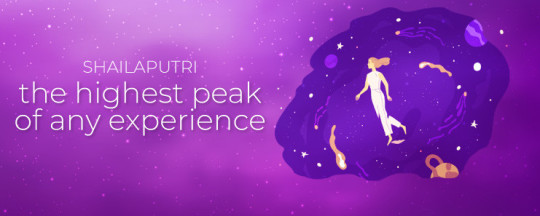
On the first day, Devi Shailaputri is worshipped. In this form, Devi Parvati is revered as the daughter of Himalaya Raja. Shaila means extraordinary or rising to great heights. The divine consciousness represented by Devi always surges from the peak. On this first day of Navratri, we propitiate Devi Shailaputri so that we may also attain the highest state of consciousness.
Second Day – Brahmacharini

On the second day, Devi Brahmacharini is propitiated. Devi Brahmacharini is the form of Devi Parvati in which she undertook severe penance to have Lord Shiva as Her consort. Brahma means divine consciousness and achar refers to behavior. Brahmacharya is the behavior or an act that is established in divine consciousness. This day is especially sacred to meditate and explore our inner divinity.
Third Day – Chandraghanta
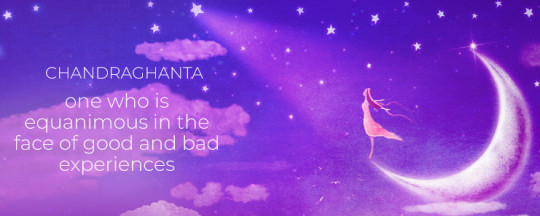
On the third day, Devi Chandraghata is the presiding Devi. Chandraghata is the special form that Devi Parvati assumed at the time of Her marriage with Lord Shiva. Chandra refers to the moon. The moon represents our mind. The mind is restless and keeps moving from one thought to another. Ghanta is a bell which produces only one kind of sound always. The significance is that when our mind is established at one point, i.e Divine, then our prana (subtle life force energy) gets consolidated leading to harmony and peace. This day thus signifies withdrawing from all vagaries of the mind, with a single focus on Mother Divine.
Fourth Day – Kushmanda
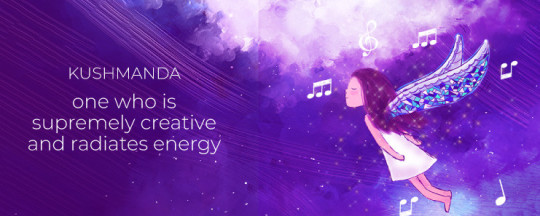
On the fourth day, Mother Divine is worshipped as Devi Kushmanda. Kushmanda means a pumpkin. Ku means little, ushma means energy and anda refers to egg. This entire universe which arose from the cosmic egg (hiranyagarbha) is manifested from an infinitesimal energy of Devi. A pumpkin also represents prana as it has the unique property of absorbing and radiating prana. It is one of the most pranic vegetables. On this day, we worship Devi Kushmanda who showers us with Her divine energy.
Fifth Day - Skandamata

Skandamata means Mother of Skanda. On the fifth day, the motherly aspect of Devi Parvati is worshipped. In this form, she is the mother of Lord Karthikeya. She represents motherly affection (vatsalya). Worshiping this form of Devi brings abundance of wisdom, wealth, power, prosperity and liberation.
Sixth Day – Katyayani
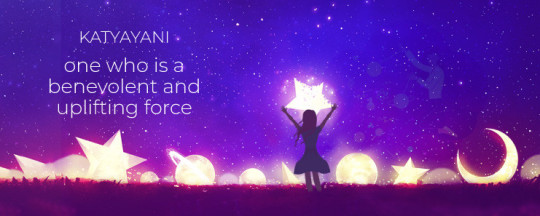
On the sixth day, Devi manifests as Katyayani. It is a form that Mother Divine assumed to annihilate the demonic forces in the universe. She was born from the anger of the gods. She is the one who slayed Mahishasura. As per our scriptures, anger that supports dharma (righteousness) is acceptable. Devi Katyayani represents that divine principle and form of the Mother Divine who is behind natural calamities and disasters. She is the anger that arises in creation to restore balance. Devi Katyayani is invoked on the sixth day to put an end to all our inner foes that are an obstacle on the path of spiritual evolution.
Seventh Day – Kalaratri
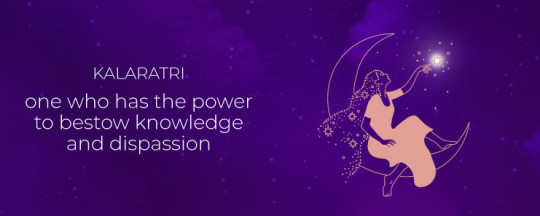
On the seventh day, we invoke Devi Kalaratri. Mother Nature has two extremes. One is terrifying and devastating. The other is beautiful and serene. Devi Kalaratri is a fierce form of Devi. Kalaratri represents the dark night. Night is also considered an aspect of Mother Divine as it is night that brings solace, rest and comfort to our souls. It is only at night that we get a glimpse of infinity in the skies. Devi Kalaratri is that infinite dark energy that houses innumerable universes.
Eighth Day – Mahagauri
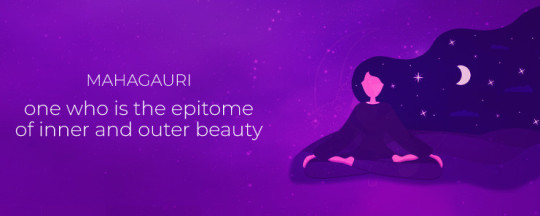
Devi Mahagauri is that which is beautiful, gives momentum and freedom in life. Mahagauri represents the beautiful and serene aspect of Nature. She is that energy which propels our lives and also liberates us. She is the Devi who is worshipped on the eighth day.
Ninth Day - Siddhidatri
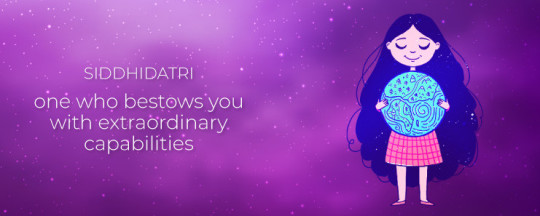
On the ninth day, we worship Devi Siddhidatri. Siddhi means perfection. Devi Siddhidatri brings perfection in life. She makes the impossible, possible. She takes us beyond the ever reasoning logical mind to explore the realm beyond time and space.
Jai Mata Ji!
4 notes
·
View notes
Text
🔱 Chandraghanta Mantra
“Om Devi Chandraghantayai Namah” is a revered mantra dedicated to Maa Chandraghanta, the third form of Goddess Durga worshipped on the third day of Navratri. Reciting this sacred chant is believed to invoke her divine protection, courage, and inner strength—helping devotees overcome fears and build unwavering confidence in challenging times.
For more details:
0 notes
Text

Maa Chandraghanta – The Goddess of Courage and Serenity ✨🙏
On the third day of Navratri, we honor Maa Chandraghanta, the embodiment of grace, bravery, and divine power. She rides a tiger, radiating strength while blessing her devotees with peace and prosperity. Her half-moon-shaped bell (Ghanta) symbolizes the removal of negativity and evil from our lives.
May Maa Chandraghanta bless you with courage, success, and harmony in all aspects of life. 🌸💫
🕉️ Jai Mata Di! 🙏🔔
✨ शुभ्र कांति, शांति और शक्ति का प्रतीक - माँ चंद्रघंटा का आशीर्वाद सदा आप पर बना रहे! ✨
#MaaChandraghanta#NavratriDay3#DivineBlessings#ShaktiSwaroopa#JaiMataDi#Navratri2025#SpiritualAwakening#GoddessOfCourage#PeaceAndProsperity#ChandraghantaMata#NavratriVibes#GoddessBlessings#ProminentRealty
0 notes
Text

✨ Navratri Day 3: Invoke the Divine Strength of Maa Chandraghanta ✨
The third form of Durga, Maa Chandraghanta, represents courage and tranquility. She holds ten weapons, rides a lion, and blesses her devotees with inner peace & fearlessness. Her bell (Ghanta) dispels evil forces, bringing positive vibrations.
May her divine energy illuminate your path! 🔥💖
📩 [email protected] 📞 +91 9999220889 🌍 www.moneymasterz.in
0 notes
Text

Goddess Chandraghanta
The third day of Navratri is dedicated to Maa Chandraghanta. Each of the auspicious nine days of Navratri is dedicated to one of the nine forms of Durga. Devi Chandraghanta is depicted as the goddess with a crescent Moon (Chandra) on her forehead. She also holds a bell (Ghanta) that symbolizes her name. The sound of the bell petrifies sinners and those on the wrong Karmic path. She represents the traits of fearlessness, protection, and purity.
Visit Now: -https://www.vinaybajrangi.com/festivals/navratri-third-day.php
0 notes
Text
9 Days, 9 Colours of Navratri Sarees and Their Significance
Introduction
Navratri, one of the most widely celebrated festivals in India, spans nine days and is dedicated to worshipping Goddess Durga in her different avatars. Each day represents a different form of the goddess, and with each form comes a unique colour that holds deep symbolic meaning. The tradition of wearing specific colours on each day of Navratri adds vibrancy to the celebrations while deepening the spiritual experience.
The Significance of Colours in Navratri
Colours play an essential role in the Navratri celebrations. Each day of the festival is associated with a distinct colour, believed to evoke the energies of the goddess who is worshipped. These colours not only set the tone for the day but also influence the mood, attire, and decorations of devotees.
Day 1: Pratipada - Colour White
White is the colour for the first day of Navratri, representing purity and serenity. Goddess Shailaputri, the first form of Durga, is worshipped on this day. Wearing a white saree signifies a clean, calm state of mind, ready to embark on the spiritual journey.
Meaning of White in Navratri
White symbolizes peace and purity, which reflects the essence of Goddess Shailaputri. It encourages an environment of calm and positivity.
Styling Tips for White Sarees
Opt for a crisp cotton or silk white saree with delicate embroidery. Pair it with silver jewelry to enhance the serene look and keep makeup minimal for a graceful appearance.
Day 2: Dwitiya - Colour Red
Red is the colour of passion and energy, making it perfect for the second day of Navratri when devotees worship Goddess Brahmacharini. This bold colour embodies the strength and fierce determination of the goddess.
Why Red Symbolizes Energy
Red has always been associated with power, vitality, and the will to overcome obstacles. It is the colour of life force and passion, which Goddess Brahmacharini personifies.
Best Fabrics for Red Sarees
Silk or Banarasi sarees in deep red shades are popular choices. Pair them with gold jewelry to bring out the richness of the colour and the spirit of the day.
Day 3: Tritiya - Colour Royal Blue
Royal blue signifies tranquillity and depth, the perfect representation of Goddess Chandraghanta, who is worshipped on the third day. This day calls for strength, courage, and boldness in your attire.
The Elegance of Royal Blue in Festivals
Royal blue is a regal colour that symbolizes wisdom and calmness. It's the perfect balance between boldness and sophistication, making it an ideal choice for festival wear.
How to Style a Royal Blue Saree
Pair a royal blue saree with heavy silver or Kundan jewelry. A bold lip shade and statement accessories will complete this stunning look.
Day 4: Chaturthi - Colour Yellow
Yellow is the colour of optimism, brightness, and happiness. Goddess Kushmanda, worshipped on the fourth day, is believed to reside in the sun, which is why yellow represents her energy.
The Auspiciousness of Yello
Yellow symbolizes the start of something new and positive, evoking feelings of joy and creativity. It’s a colour that encourages warmth and openness.
Traditional Yellow Saree Looks
Opt for a yellow silk saree with zari work or a simple cotton saree with bright accents. Pair it with floral jewelry or gold accessories for a traditional, festive look.
Day 5: Panchami - Colour Green
Green represents nature, growth, and prosperity. Goddess Skandamata worshipped on the fifth day, brings the energy of nurturing and the life-sustaining powers of nature.
Green as a Symbol of Nature and Prosperity
Wearing green during Navratri is believed to attract prosperity, fertility, and good health. It's a tribute to the nurturing aspect of the goddess.
Saree Draping Tips for Green Sarees
Experiment with a modern drape or stick to a traditional draping style. A green saree with gold or red accents works well for this day, and don’t forget to accessorize with bangles and earrings.
Day 6: Shashti - Colour Grey
Grey, often associated with balance and mystery, is the colour of the sixth day of Navratri, dedicated to Goddess Katyayani. Grey invokes the power to overcome evil while maintaining balance.
The Power of Grey and Its Mystical Meaning
Grey embodies neutrality, wisdom, and the ability to rise above life's dualities. It's a fitting choice for those seeking protection and peace on this day.
How to Make Grey Sarees Look Glamorous
Choose a grey saree with metallic or sequined work to add glamour. Pair it with bold makeup or statement jewelry to make the look stand out in an otherwise understated colour.
Day 7: Saptami - Colour Orange
Orange signifies warmth, enthusiasm, and energy. It’s a vibrant, eye-catching colour perfect for celebrating Goddess Kalaratri, who represents courage and protection.
Orange as a Colour of Enthusiasm
The brightness of orange is believed to enhance enthusiasm and positive energy. It invokes the strength of the goddess, who fiercely protects her devotees.
Styling Orange Sarees for Festive Occasions
Choose an orange saree in silk or chiffon for a vibrant look. Gold accents work well with this colour, and you can play around with layered necklaces or jhumkas to make a bold statement.
Day 8: Ashtami - Colour Peacock Green
Peacock green is a unique and royal colour associated with Goddess Mahagauri. This colour represents uniqueness and auspiciousness, perfect for Ashtami, one of the most significant days of Navratri.
The Royal Significance of Peacock Green
This colour is seen as both royal and auspicious. Peacock green sarees often incorporate luxurious fabrics like silk or satin, adding a touch of grandeur to the celebrations.
Unique Peacock Green Saree Designs
Opt for rich, embroidered peacock green sarees. Pair them with statement jewelry like pearls or traditional gold necklaces for an exquisite festival look.
Day 9: Navami - Colour Purple
Purple, the colour of spirituality and transformation, is worn on the final day of Navratri, dedicated to Goddess Siddhidatri. This colour symbolizes the ultimate form of feminine energy and enlightenment.
Purple as a Colour of Spirituality
Purple is associated with wisdom, spirituality, and transformation. Wearing this colour on the last day signifies the culmination of the Navratri journey and the attainment of divine blessings.
Enhancing Your Look with a Purple Saree
Pair a purple saree with contrasting accessories like silver or emerald jewelry. Opt for elegant makeup with bold eyeliner to complement the regal essence of this colour.
Navratri Saree Styling Tips for the Entire Festival
Throughout Navratri, the choice of saree is not just about fashion but also about tradition and devotion. To make the most out of the festive wardrobe:
Mix and match your saree styles with modern drapes.
Pair traditional sarees with contemporary accessories.
Keep your makeup and jewelry choices aligned with the day’s colour to complete your look.
Conclusion
Navratri is a celebration of colours, devotion, and joy. Each day, marked by a different colour, signifies a unique spiritual and emotional journey that devotees undertake. The tradition of wearing specific saree colours adds richness and meaning to the festivities, making it an integral part of the celebration.
FAQs
What is the significance of wearing specific colours during Navratri?
Each colour represents a particular goddess and holds spiritual significance, enhancing the devotee’s connection to the divine.
Can I wear other colours during Navratri?
While there’s a traditional colour assigned to each day, you can certainly personalize your attire according to your preferences.
How can I accessorize my sarees for Navratri?
Opt for jewelry that complements the colour of the day. You can experiment with traditional pieces like jhumkas, bangles, and kundan necklaces.
Are there any regional variations in Navratri saree colours?
Yes, saree colour traditions can vary slightly depending on the region, but the core concept of celebrating each day with a distinct colour remains the same.
Where can I buy traditional Navratri sarees online?
Many online platforms offer a wide variety of Navratri sarees, including Amazon, Flipkart, and specialized ethnic stores.
0 notes
Text
[ad_1] The Prime Minister Narendra Modi today launched the ‘Bima Sakhi Yojana’ of Life Insurance Corporation, in line with his commitment to women empowerment and financial inclusion, in Panipat, Haryana. During the occasion, he also laid the foundation stone of the Main campus of Maharana Pratap Horticultural University, Karnal. Addressing the gathering, Modi said that today India was taking another strong step towards women empowerment. He added that today being the 9th day of the month was special as number 9 was considered auspicious in our scriptures and was associated with the nine forms of Nav Durga, worshipped during the Navratri. He remarked that today is also a day of worship of Nari Shakti. The Prime Minister recollected that it was on 9th December, the first meeting of the Constituent Assembly was held and today when the country was celebrating 75 years of the Constitution, the date inspires us to ensure equality and holistic development. Lauding Haryana as a great land that gave the world the knowledge of ethics and religion, Modi was pleased that at this time, the International Gita Jayanti Mahotsav was also being held in Kurukshetra. He paid respects to the land of Gita and greeted all the patriotic people of Haryana. Modi lauded the people of Haryana for adopting the mantra of ‘Ek hain to Safe hain’, which had become an example for the entire country. Expressing his unflinching relationship and attachment with Haryana, the Prime Minister thanked the people for electing them to power for the third time in a row. He added that the newly formed state Government was being praised from all quarters despite being formed recently. He further added that the country has witnessed the way thousands of youth have got permanent jobs here without corruption after the formation of the government. Thanking the women of Haryana, Shri Modi remarked that he had launched the Bima Sakhi scheme, which provides employment to the women of the country and congratulated all for the same. Recounting his privilege of launching the Beti Bachao, Beti Padhao campaign from Panipat, a few years ago, the Prime Minister underlined that it had a positive impact in Haryana as well as the entire country. He added that in Haryana alone, lives of thousands of daughters’ were saved in the last decade. Modi remarked that now after a decade, the Bima Sakhi Yojana for sisters and daughters was being launched from this very land of Panipat. He added that Panipat had become a symbol of women power. Highlighting that India was treading forward with the resolution of Viksit Bharat by 2047, Modi said that from 1947 till today, the energy of every class and region has taken India to this height. He added that however, to achieve the resolution of a developed India by 2047, India needs many new sources of energy. North-East India being one such source, Modi said Nari Shakti of India was another important source of energy in the form of women self-help groups, insurance sakhi, bank sakhi, agriculture sakhi which would bolster the resolution of developed India. The Prime Minister stressed that it was imperative to ensure ample opportunities and remove every obstacle in their way to empower women. He added that when women were empowered, new doors of opportunities opened for the country. Highlighting that the Government opened up many jobs which were forbidden for women, Modi remarked that the daughters of India were being deployed in the front lines of the army today. He added that India’s daughters, in large numbers, were becoming fighter pilots, recruited in police and heading corporate companies too. The Prime Minister noted that there were 1200 producer associations or cooperative societies of farmers and cattle rearers in the country, led by women. He added that girls were moving ahead in every field from sports to education. He further added that lakhs of daughters have also benefited from increasing the maternity leave for pregnant women to 26 weeks.
The Prime Minister remarked that the foundation of the Bima Sakhi programme, launched today, was also based on years of hard work and penance. Noting that most women lacked bank accounts after 6 decades of independence, he said that women were cut off from the entire banking system. Expressing pride over 30 crore women accounts under Jan Dhan Yojana, Shri Modi said that his Government opened the Jan Dhan accounts for women to ensure the subsidies like Gas subsidy reach the responsible hands of the family. He added that Jan Dhan Yojana has also helped in ensuring the transfer of money from schemes like Kisan Kalyan Nidhi, Sukanya Samridhi Yojana, funds to build own houses, funds to set up shops for hawkers, Mudra Yojana and others. Lauding the women for having played a major role in providing banking facilities in every village, the Prime Minister said that those who did not even have bank accounts are now connecting the villagers to banks as Bank Sakhi. He added that the Bank Sakhis have started teaching people how to save money in a bank, how to get a loan and lakhs of such Bank Sakhis are providing services in every village today. Recollecting that women of India were not insured earlier, Shri Modi remarked that today a campaign was started to make lakhs of women insurance agents or Bima Sakhi. He added that now women will also lead the expansion of sectors like insurance. The Prime Minister stressed that the target was to provide employment opportunities to 2 lakh women under the Bima Sakhi Yojana. He added that girls who had completed their class 10 would be trained and given financial help for three years under the Bima Sakhi Yojana. Citing data related to the insurance sector which showed that a LIC agent earns an average of 15 thousand rupees every month, Modi said that our Bima Sakhis would earn more than 1.75 lakh rupees every year which would give additional income to the family. Noting that the contribution of Bima Sakhis would be much more apart from earning money, the Prime Minister said ‘Insurance for All’ in India was the aim at the end of the day. He added that it was necessary for social security and to eradicate poverty from its roots. He further emphasised that the Bima Sakhis will strengthen the mission of Insurance for All. Underlining that when an individual is insured, the benefit gained is immense, Modi said the Government was implementing Pradhan Mantri Jeevan Jyoti Bima and Pradhan Mantri Suraksha Bima Yojanas. He added that an insurance of Rs 2 lakh was provided at a very low premium under these schemes. Modi noted that more than 20 crore people of the country who could never even think of insurance, have been insured. He added that under these two schemes, a claim amount of about Rs 20 thousand crore has been given so far. Modi remarked that Bima Sakhis would be working to provide social security cover to many families of the country, a kind of a virtuous work. Emphasising that the revolutionary policies made for rural women in India in the last 10 years along with the policy decisions undertaken was indeed a subject of study, the Prime Minister said even though the titles of Bima Sakhi, Bank Sakhi, Krishi Sakhi, Pashu Sakhi, Drone Didi, Lakhpati didi sound simple and common, they are transforming the fate of India. He added that India’s Self Help Group Abhiyaan would be scripted in golden letters in history considering the empowerment of women done by it. Modi remarked that the Government had made women self-help groups a big medium to bring about change in the rural economy. He added that 10 crore women across the country are associated with self-help groups and more than 8 lakh crore rupees of help to the women of self-help groups in the last decade. Lauding the role and contribution of the women, associated with Self Help Groups across the country, as extraordinary, the Prime Minister remarked that they were working to make India the third largest economic power in the world.
Noting that women from every society, class and family were associated with this, he added that every woman was getting opportunities in this. He further remarked that the movement of Self Help Groups was also strengthening social harmony and social justice. The Prime Minister highlighted that the Self Help Groups were not only increasing the income of one woman, but also increasing the confidence of a family, and the entire village. He lauded all of them for the good work being carried out. Modi also recounted his announcement made from the ramparts of Red Fort to make 3 crore Lakhpati Didis and so far more than 1 crore 15 lakh Lakhpati Didis have been made across the country. He added that these women have started earning more than one lakh rupees every year. The Prime Minister remarked that the Lakhpati Didi campaign was also getting much needed support from the Government’s Namo Drone Didi Yojana, which is discussed even in Haryana. Shri Modi narrated the account of a Namo Drono Didi from Haryana and said that this scheme was transforming both agriculture and the lives of women. The Prime Minister highlighted that thousands of Krishi Sakhis were being trained to raise awareness about modern farming and natural farming in the country. He added that about 70 thousand Krishi Sakhis had already received certificates and these Krishi Sakhis had the capacity to earn more than 60 thousand rupees every year. Discussing about the Pashu Sakhis, Modi said more than 1.25 lakh Pashu Sakhis are today a part of the awareness campaign about animal husbandry. He added that these were not just a means of employment but doing a great service to humanity. He remarked that Krishi Sakhis were not only working to save the earth for future generations, but also serving the soil and our farmers by spreading awareness about natural farming. Similarly, he added that our Pashu Sakhis were doing a pious work of serving humanity by serving animals. Emphasising the love and affection received from the sisters and mothers of the country, Shri Modi said his Government built more than 12 crore toilets in the country in the last 10 years which helped many women whose houses had no toilets. Similarly, he added, free gas cylinder connections were given to crores of women who had no gas connection 10 years ago. He further added that tap water connections, pucca houses were also ensured to women who lacked them. The Prime Minister highlighted that the legislation ensuring 33 percent reservation for women in the Vidhan Sabha and Lok Sabha was also enacted. He added that the blessings of mothers and sisters would be ensured only when such honest efforts are made with the right intentions. Touching upon the work being done for the welfare of the farmers by their Center and State Governments, the Prime Minister underscored that in the first two terms, the farmers of Haryana had received more than 1.25 lakh crore rupees as MSP, while after the formation of the government for the third time in Haryana, 14 thousand crore rupees was given to paddy, millet and moong farmers as MSP. He added that more than 800 crore rupees was also given to help drought affected farmers. Recounting the major role played by Chaudhary Charan Singh University in making Haryana the leader of Green Revolution, Shri Modi said that now in the 21st century, the role of Maharana Pratap University would be imperative in making Haryana a leader in the field of horticulture. He added that today, the foundation stone of the new campus of Maharana Pratap Horticulture University was laid and it would provide new facilities to the youth studying in this university. Concluding his address, Modi assured the women of Haryana that the state would develop rapidly and the Governments at the Center and State would work three times faster in their third term. He expressed confidence that the role of women power in Haryana would continue to grow stronger. The Governor of Haryana, Bandaru Dattatreya,
Chief Minister of Haryana, Nayab Singh Saini, Union Minister for Finance and Corporate Affairs, Nirmala Sitharaman, Union Minister for Housing and Urban Affairs and Power, Manohar Lal, Minister of State for Cooperation, Krishan Pal and other dignitaries were present at the event. WATCH VIDEO BELOW – [embed]https://www.youtube.com/watch?v=JRaAijETBrI[/embed] [ad_2] Source link
0 notes
Text
[ad_1] The Prime Minister Narendra Modi today launched the ‘Bima Sakhi Yojana’ of Life Insurance Corporation, in line with his commitment to women empowerment and financial inclusion, in Panipat, Haryana. During the occasion, he also laid the foundation stone of the Main campus of Maharana Pratap Horticultural University, Karnal. Addressing the gathering, Modi said that today India was taking another strong step towards women empowerment. He added that today being the 9th day of the month was special as number 9 was considered auspicious in our scriptures and was associated with the nine forms of Nav Durga, worshipped during the Navratri. He remarked that today is also a day of worship of Nari Shakti. The Prime Minister recollected that it was on 9th December, the first meeting of the Constituent Assembly was held and today when the country was celebrating 75 years of the Constitution, the date inspires us to ensure equality and holistic development. Lauding Haryana as a great land that gave the world the knowledge of ethics and religion, Modi was pleased that at this time, the International Gita Jayanti Mahotsav was also being held in Kurukshetra. He paid respects to the land of Gita and greeted all the patriotic people of Haryana. Modi lauded the people of Haryana for adopting the mantra of ‘Ek hain to Safe hain’, which had become an example for the entire country. Expressing his unflinching relationship and attachment with Haryana, the Prime Minister thanked the people for electing them to power for the third time in a row. He added that the newly formed state Government was being praised from all quarters despite being formed recently. He further added that the country has witnessed the way thousands of youth have got permanent jobs here without corruption after the formation of the government. Thanking the women of Haryana, Shri Modi remarked that he had launched the Bima Sakhi scheme, which provides employment to the women of the country and congratulated all for the same. Recounting his privilege of launching the Beti Bachao, Beti Padhao campaign from Panipat, a few years ago, the Prime Minister underlined that it had a positive impact in Haryana as well as the entire country. He added that in Haryana alone, lives of thousands of daughters’ were saved in the last decade. Modi remarked that now after a decade, the Bima Sakhi Yojana for sisters and daughters was being launched from this very land of Panipat. He added that Panipat had become a symbol of women power. Highlighting that India was treading forward with the resolution of Viksit Bharat by 2047, Modi said that from 1947 till today, the energy of every class and region has taken India to this height. He added that however, to achieve the resolution of a developed India by 2047, India needs many new sources of energy. North-East India being one such source, Modi said Nari Shakti of India was another important source of energy in the form of women self-help groups, insurance sakhi, bank sakhi, agriculture sakhi which would bolster the resolution of developed India. The Prime Minister stressed that it was imperative to ensure ample opportunities and remove every obstacle in their way to empower women. He added that when women were empowered, new doors of opportunities opened for the country. Highlighting that the Government opened up many jobs which were forbidden for women, Modi remarked that the daughters of India were being deployed in the front lines of the army today. He added that India’s daughters, in large numbers, were becoming fighter pilots, recruited in police and heading corporate companies too. The Prime Minister noted that there were 1200 producer associations or cooperative societies of farmers and cattle rearers in the country, led by women. He added that girls were moving ahead in every field from sports to education. He further added that lakhs of daughters have also benefited from increasing the maternity leave for pregnant women to 26 weeks.
The Prime Minister remarked that the foundation of the Bima Sakhi programme, launched today, was also based on years of hard work and penance. Noting that most women lacked bank accounts after 6 decades of independence, he said that women were cut off from the entire banking system. Expressing pride over 30 crore women accounts under Jan Dhan Yojana, Shri Modi said that his Government opened the Jan Dhan accounts for women to ensure the subsidies like Gas subsidy reach the responsible hands of the family. He added that Jan Dhan Yojana has also helped in ensuring the transfer of money from schemes like Kisan Kalyan Nidhi, Sukanya Samridhi Yojana, funds to build own houses, funds to set up shops for hawkers, Mudra Yojana and others. Lauding the women for having played a major role in providing banking facilities in every village, the Prime Minister said that those who did not even have bank accounts are now connecting the villagers to banks as Bank Sakhi. He added that the Bank Sakhis have started teaching people how to save money in a bank, how to get a loan and lakhs of such Bank Sakhis are providing services in every village today. Recollecting that women of India were not insured earlier, Shri Modi remarked that today a campaign was started to make lakhs of women insurance agents or Bima Sakhi. He added that now women will also lead the expansion of sectors like insurance. The Prime Minister stressed that the target was to provide employment opportunities to 2 lakh women under the Bima Sakhi Yojana. He added that girls who had completed their class 10 would be trained and given financial help for three years under the Bima Sakhi Yojana. Citing data related to the insurance sector which showed that a LIC agent earns an average of 15 thousand rupees every month, Modi said that our Bima Sakhis would earn more than 1.75 lakh rupees every year which would give additional income to the family. Noting that the contribution of Bima Sakhis would be much more apart from earning money, the Prime Minister said ‘Insurance for All’ in India was the aim at the end of the day. He added that it was necessary for social security and to eradicate poverty from its roots. He further emphasised that the Bima Sakhis will strengthen the mission of Insurance for All. Underlining that when an individual is insured, the benefit gained is immense, Modi said the Government was implementing Pradhan Mantri Jeevan Jyoti Bima and Pradhan Mantri Suraksha Bima Yojanas. He added that an insurance of Rs 2 lakh was provided at a very low premium under these schemes. Modi noted that more than 20 crore people of the country who could never even think of insurance, have been insured. He added that under these two schemes, a claim amount of about Rs 20 thousand crore has been given so far. Modi remarked that Bima Sakhis would be working to provide social security cover to many families of the country, a kind of a virtuous work. Emphasising that the revolutionary policies made for rural women in India in the last 10 years along with the policy decisions undertaken was indeed a subject of study, the Prime Minister said even though the titles of Bima Sakhi, Bank Sakhi, Krishi Sakhi, Pashu Sakhi, Drone Didi, Lakhpati didi sound simple and common, they are transforming the fate of India. He added that India’s Self Help Group Abhiyaan would be scripted in golden letters in history considering the empowerment of women done by it. Modi remarked that the Government had made women self-help groups a big medium to bring about change in the rural economy. He added that 10 crore women across the country are associated with self-help groups and more than 8 lakh crore rupees of help to the women of self-help groups in the last decade. Lauding the role and contribution of the women, associated with Self Help Groups across the country, as extraordinary, the Prime Minister remarked that they were working to make India the third largest economic power in the world.
Noting that women from every society, class and family were associated with this, he added that every woman was getting opportunities in this. He further remarked that the movement of Self Help Groups was also strengthening social harmony and social justice. The Prime Minister highlighted that the Self Help Groups were not only increasing the income of one woman, but also increasing the confidence of a family, and the entire village. He lauded all of them for the good work being carried out. Modi also recounted his announcement made from the ramparts of Red Fort to make 3 crore Lakhpati Didis and so far more than 1 crore 15 lakh Lakhpati Didis have been made across the country. He added that these women have started earning more than one lakh rupees every year. The Prime Minister remarked that the Lakhpati Didi campaign was also getting much needed support from the Government’s Namo Drone Didi Yojana, which is discussed even in Haryana. Shri Modi narrated the account of a Namo Drono Didi from Haryana and said that this scheme was transforming both agriculture and the lives of women. The Prime Minister highlighted that thousands of Krishi Sakhis were being trained to raise awareness about modern farming and natural farming in the country. He added that about 70 thousand Krishi Sakhis had already received certificates and these Krishi Sakhis had the capacity to earn more than 60 thousand rupees every year. Discussing about the Pashu Sakhis, Modi said more than 1.25 lakh Pashu Sakhis are today a part of the awareness campaign about animal husbandry. He added that these were not just a means of employment but doing a great service to humanity. He remarked that Krishi Sakhis were not only working to save the earth for future generations, but also serving the soil and our farmers by spreading awareness about natural farming. Similarly, he added that our Pashu Sakhis were doing a pious work of serving humanity by serving animals. Emphasising the love and affection received from the sisters and mothers of the country, Shri Modi said his Government built more than 12 crore toilets in the country in the last 10 years which helped many women whose houses had no toilets. Similarly, he added, free gas cylinder connections were given to crores of women who had no gas connection 10 years ago. He further added that tap water connections, pucca houses were also ensured to women who lacked them. The Prime Minister highlighted that the legislation ensuring 33 percent reservation for women in the Vidhan Sabha and Lok Sabha was also enacted. He added that the blessings of mothers and sisters would be ensured only when such honest efforts are made with the right intentions. Touching upon the work being done for the welfare of the farmers by their Center and State Governments, the Prime Minister underscored that in the first two terms, the farmers of Haryana had received more than 1.25 lakh crore rupees as MSP, while after the formation of the government for the third time in Haryana, 14 thousand crore rupees was given to paddy, millet and moong farmers as MSP. He added that more than 800 crore rupees was also given to help drought affected farmers. Recounting the major role played by Chaudhary Charan Singh University in making Haryana the leader of Green Revolution, Shri Modi said that now in the 21st century, the role of Maharana Pratap University would be imperative in making Haryana a leader in the field of horticulture. He added that today, the foundation stone of the new campus of Maharana Pratap Horticulture University was laid and it would provide new facilities to the youth studying in this university. Concluding his address, Modi assured the women of Haryana that the state would develop rapidly and the Governments at the Center and State would work three times faster in their third term. He expressed confidence that the role of women power in Haryana would continue to grow stronger. The Governor of Haryana, Bandaru Dattatreya,
Chief Minister of Haryana, Nayab Singh Saini, Union Minister for Finance and Corporate Affairs, Nirmala Sitharaman, Union Minister for Housing and Urban Affairs and Power, Manohar Lal, Minister of State for Cooperation, Krishan Pal and other dignitaries were present at the event. WATCH VIDEO BELOW – [embed]https://www.youtube.com/watch?v=JRaAijETBrI[/embed] [ad_2] Source link
0 notes